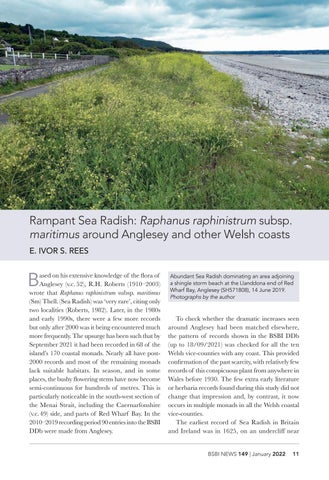Rampant Sea Radish: Raphanus raphinistrum subsp. maritimus around Anglesey and other Welsh coasts E. IVOR S. REES
B
ased on his extensive knowledge of the flora of Anglesey (v.c. 52), R.H. Roberts (1910–2003) wrote that Raphanus raphinistrum subsp. maritimus (Sm) Thell. (Sea Radish) was ‘very rare’, citing only two localities (Roberts, 1982). Later, in the 1980s and early 1990s, there were a few more records but only after 2000 was it being encountered much more frequently. The upsurge has been such that by September 2021 it had been recorded in 68 of the island’s 170 coastal monads. Nearly all have post2000 records and most of the remaining monads lack suitable habitats. In season, and in some places, the bushy flowering stems have now become semi-continuous for hundreds of metres. This is particularly noticeable in the south-west section of the Menai Strait, including the Caernarfonshire (v.c. 49) side, and parts of Red Wharf Bay. In the 2010–2019 recording period 90 entries into the BSBI DDb were made from Anglesey.
Abundant Sea Radish dominating an area adjoining a shingle storm beach at the Llanddona end of Red Wharfay, B gln esey(SH571808),14enuJ 1902 . Photographs by the author
To check whether the dramatic increases seen around Anglesey had been matched elsewhere, the pattern of records shown in the BSBI DDb (up to 18/09/2021) was checked for all the ten Welsh vice-counties with any coast. This provided confirmation of the past scarcity, with relatively few records of this conspicuous plant from anywhere in Wales before 1930. The few extra early literature or herbaria records found during this study did not change that impression and, by contrast, it now occurs in multiple monads in all the Welsh coastal vice-counties. The earliest record of Sea Radish in Britain and Ireland was in 1625, on an undercliff near BSBI NEWS 149 | January 2022
11












